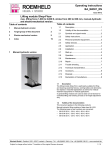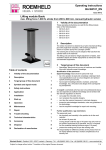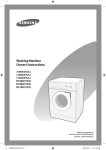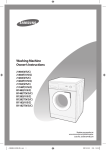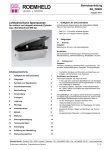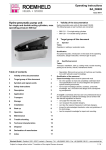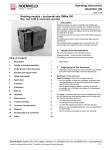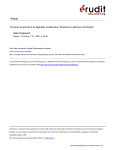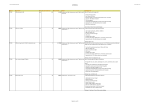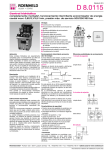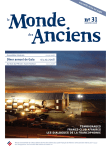Download Operating instructions BA_B1282_EN Hydro
Transcript
Operating instructions BA_B1282_EN Issue 11-12 Hydro-cylinders with optional stroke end cushioning double acting, max. operating pressure 200 bar 1 Description Double-acting hydro-cylinders with connecting dimensions according to DIN ISO 6020. The piston rod is provided with an external thread and is hardened and chromium-plated. For fixing the front and rear housing part is equipped with 4 interior threads. Also an effective wiper seal is available. The adjustable stroke end cushioning avoids a crash stop of the piston in the cylinder body in case of the following applications: 1. High piston speed 2. Additional load at the piston rod and 3. An external stop to compensate the additional load is not possible. 2 Table of contents 1 Description 1 2 Validity of the documentation 1 3 Target group of this document 1 4 Symbols and signal words 2 5 Safety instructions 2 6 Application 3 7 Installation 3 8 Start up 6 9 Maintenance 7 10 Trouble shooting 7 11 Technical characteristics 7 12 Accessory 8 13 Storage 8 14 Disposal 8 15 Declaration of manufacture 8 Validity of the documentation This document applies to the following products: Block cylinders of data sheet B 1.282. The following types or part numbers are concerned: • 1293-10-XXXX, -11-XXXX, -12-XXXX, -13-XXXX. • 1294-10-XXXX, -11-XXXX, -12-XXXX, -13-XXXX. • 1295-10-XXXX, -11-XXXX, -12-XXXX, -13-XXXX. • 1296-10-XXXX, -11-XXXX, -12-XXXX, -13-XXXX. • 1297-10-XXXX, -11-XXXX, -12-XXXX, -13-XXXX. • 1298-10-XXXX, -11-XXXX, -12-XXXX, -13-XXXX. -XXXX corresponds to the stroke in mm. 3 Target group of this document • Specialists, fitters and set-up men of machines and installations with hydraulic expert knowledge. Qualification of the personnel Expert knowledge means that the personnel must • be in the position to read and completely understand technical specifications such as circuit diagrams and productspecific drawing documents, • have expert knowledge (electric, hydraulic, pneumatic knowledge, etc.) of function and design of the corresponding components. An expert is somebody who has due to its professional education and experiences sufficient knowledge and is familiar with the relevant regulations so that he • can judge the entrusted works, • can recognize the possible dangers, • can take the required measures to eliminate dangers, • knows the acknowledged standards, rules and guidelines of the technology. • has the required knowledge for repair and mounting. Römheld GmbH • Postfach 1253 • 35317 Laubach • Germany • Tel.: +49 (0)6405 / 89-0 • Fax: +49 (0)6405 / 89-211 • www.roemheld.de Subject to change without notice! Translation of the original German document 1/8 Operating instructions BA_B1282_EN 4 Symbols and signal words DANGER Danger of life / heavy health damages Stands for an imminent danger. If it is not avoided, death or very severe injuries will result. WARNING Person damage Stands for a possibly dangerous situation. If it is not avoided, death or very severe injuries will result. CAUTION Easy injuries / property damage Stands for a possibly dangerous situation. If it is not avoided, minor injuries or material damages will result. Hazardous to the environment The symbol stands for important information for the proper handling with materials that are hazardous to the environment. Ignoring these notes can lead to heavy damages to the environment. Mandatory sign! The symbol stands for important information, necessary protection equipment, etc. Note This symbol stands for tips for users or especially useful information. This is no signal word for a dangerous or harmful situation. 5 Safety instructions 5.1 Basic information The operating instructions serve for information and avoidance of dangers when installing the products into the machine as well as information and references for transport, storage and maintenance. Only in strict compliance with these operating instructions, accidents and property damages can be avoided as well as trouble-free operation of the products can be guaranteed. Furthermore, the consideration of the operating instructions will result in: • reduced down times and repair costs, • increased service life of the products. Note These operating instructions are not a replacement for the operating instructions of the entire machine. 5.2 General safety tips WARNING Poisoning due to contact with hydraulic oil! Wear, damage of the seals, ageing and incorrect mounting of the seal kit by the operator can lead to escapes of oil. Incorrect connection can lead to escapes of oil at the ports. For handling with hydraulic oil consider the material safety data sheet. Wear protection equipment. WARNING Injury by high-pressure injection (squirting out of hydraulic oil under high pressure)! Improper connection can lead to escapes of oil under high pressure at the connections. Mounting or dismounting of the element must only be made in depressurised mode of the hydraulic system. Connection of the hydraulic line as per DIN 3852/ISO 1179. Unused connections have to be locked professionally. Use all mounting holes. WARNING Injury by high-pressure injection (squirting out of hydraulic oil under high pressure)! Wear, damage of the seals, ageing and incorrect mounting of the seal kit by the operator can lead to escapes of oil under high pressure. Before using them make a visual control. WARNING Injury by crushing! Components of the product make a movement while they are in operation. This can cause injuries. Keep parts of the body and items out of the working area! CAUTION Damage of components! Side loads and forced conditions on the plunger lead to premature failure. Provide external guides. Avoid forced conditions (overdetermination) of the plunger. Do not introduce any torques. CAUTION Damage of components! The maximum operating pressure of 200 bar must not be exceeded. 2/8 Operating instructions BA_B1282_EN CAUTION Damage of components! With hydraulic pressure very high forces are generated. The fixture or machine must be in the position to compensate these forces. Note - qualification of the user All works may only be effected by qualified personnel familiar with the handling of hydraulic components. 6 Application 6.1 Intended use The products are used in industrial applications to transform hydraulic pressure to a linear movement and /or force. They must only be operated with hydraulic oil. Furthermore the following belongs to possible uses: • Use within the capacity indicated in the technical characteristics (see data sheet). • Use as per operating instructions. • Compliance with service intervals. • Qualified and trained personnel for the corresponding activities. • Mounting of spare parts only with the same specifications as the original part. 6.2 Misapplication WARNING Injuries, material damages or malfunctions! Do not modify the product! The use of these products is not admitted: • For domestic use. • On pallets or machine tool tables in primary shaping and metal forming machine tools. • If due to vibrations or other physical / chemical effects damages of the products or seals can be caused. • In machines, on pallets or machine tool tables that are used to change the characteristics of the material (magnetise, radiation, photochemical procedures, etc.). • In areas for which special guidelines apply, especially installations and machines: - For the use on fun fairs and in leisure parks. - In food processing or in areas with special hygiene regulations. - For military purposes. - In mines. - In explosive and aggressive environments (e.g. ATEX). - In medical engineering. - In the aerospace industry. - For passenger transport. • For other operating and environmental conditions e.g.: - Higher operating pressures than indicated on the data sheet or installation drawing. - With hydraulic fluids that do not correspond to the specifications. - Higher flow rates than indicated on the data sheet or installation drawing. Side load acting on the piston rod The application of side loads to the piston rod as well as the use of the product as a guiding element is inadmissible. Special solutions are available on request! 7 Installation WARNING Injury by high-pressure injection (squirting out of hydraulic oil under high pressure)! Improper connection can lead to escapes of oil under high pressure at the connections. Mounting or dismounting of the element must only be made in depressurised mode of the hydraulic system. Connection of the hydraulic line as per DIN 3852/ISO 1179. Unused connections have to be locked professionally. Use all mounting holes. WARNING Injury by high-pressure injection (squirting out of hydraulic oil under high pressure)! Wear, damage of the seals, ageing and incorrect mounting of the seal kit by the operator can lead to escapes of oil under high pressure. Before using them make a visual control. WARNING Injury by falling parts! Keep hands and other parts of the body out of the working area. Wear personal protection equipment! WARNING Poisoning due to contact with hydraulic oil! Wear, damage of the seals, ageing and incorrect mounting of the seal kit by the operator can lead to escapes of oil. Incorrect connection can lead to escapes of oil at the ports. For handling with hydraulic oil consider the material safety data sheet. Wear protection equipment. CAUTION Damage of components! Some product types have a considerable weight. These have to be secured against working free during transport. Weight specifications see chapter "Technical characteristics". 3/8 Operating instructions BA_B1282_EN 7.3 CAUTION Admissible oil flow rate WARNING Damage of components! Side loads and forced conditions acting on the piston lead to increased wear. Provide external guides. Avoid forced conditions (overdetermination) of the piston. 7.1 Injury due to overload of the element High-pressure injection (squirting out of hydraulic oil under high pressure) or flying components! Due to throttling or closing of ports a pressure intensification can occur. Connect the ports professionally! Design CAUTION Damage of components! The maximum flow rate must not be exceeded. 7.3.1 Calculation of the admissible flow rate Admissible oil flow rate The admissible flow rate or the admissible stroke speed is valid for vertical mounting positions in combination with standard add-on parts as clamping arms or contact bolts, etc. In case of other mounting positions and/or add-on parts the flow rate has to be reduced. If the pump flow rate divided by the number of elements is larger than the admissible flow rate of one element, the flow rate has to be throttled. This prevents an overload and therewith an early failure. The flow rate can be checked as follows: • QP ≤ 0,06 ⋅ V Z ⋅ n Figure 1: Components a b c 7.2 Hydraulic port (A extend, B retract) Piston rod with external thread Fixing possibilities e1 Stroke end cushioning extending e2 Stroke end cushioning retracting f Cylinder head QP ≤ 6 ⋅ vZ ⋅ AK ⋅ n for clamping elements and work supports (indicated on the data sheets) Maximum piston speed At specified pump flow rate Q and with the effective piston area A the piston speed can be calculated as follows: vm < Mounting types and/or QP 6 ⋅ AK ⋅ n Legend • VZ QP 3 = Admissible flow rate of the element in [cm /s] = Flow rate of the pump in [l/min] 2 AK = Piston area in [cm ] n = Number of elements, same dimensions vZ = vm = Admissible/maximum stroke speed in [m/s] Figure 2: Fixing possibilities 1 2 Flange mounting at front Flange mounting at front with accessory flange 3 4 Flange mounting at rear Flange mounting at rear with accessory flange Note The maximum oil volume and/or the maximum stroke speed depend on the corresponding product. • For clamping cylinders see data sheet A 0.100. • For clamping elements, work supports, hydraulic valves, power units and other hydraulic elements indicated on the corresponding data sheets. 4/8 Operating instructions BA_B1282_EN 7.5 Installation of manifold-mounted types Further " things worth knowing about hydraulic cylinders, basics, detailed knowledge and calculations on hydraulic cylinders" see in the Technical library on the internet! or download 7.3.2 Throttling of the flow rate The throttling always has to be effected in the supply line to the swing clamp. Only thus pressure intensification and thereby pressures exceeding the operating pressure are avoided. The hydraulic circuit diagram shows flow control valves which allow oil return from the element without any impediments. Figure 4: Example, preparation for hydraulic ports without pipes Note The shown figure is a schematic diagram. The arrangement of the ports depends on the respective product (see chapter "Design"). a b c Figure 3: Hydraulic circuit diagram without flow control valves a Throttling direction b Free flow If a return-flow throttling is required due to a negative load, it must be guaranteed that the max. operating pressure (see technical characteristics) will not be exceeded. 7.4 Installation of pipe-mounted types 1. Clean the support surfaces. 2. Fasten the element support at the flange surface (see figure "Mounting types"). WARNING Injury by falling products! Safety shoes have to be worn to avoid injuries due to falling objects. Note To determine the tightening torque of the fixing screws a screw calculation as per VDI 2230 page 1 has to be effected. The screw material is indicated in the chapter "Technical characteristics". d Socket head cap screw Sealing ring Countersunk plug against dirt during transport O-ring (accessory, depending on the version) d1 Mounted O-ring e Screw plug (accessory) e1 Mounted screw plug 1. Drill the holes for hydraulic oil supply and return in the fixture (see also data sheet). 2. Grind or finish mill the manifold-mounting surface (Ra 0.8 and a flatness of 0.04 mm to 100 mm, marks, scratches, shrink holes, concentric machining marks are inadmissible). For some versions: 3a. Remove socket head cap screws, countersunk plugs and sealing rings, insert o-rings (accessories, if required). 3b. Tighten pipe ports with screw plugs (accessories, if required) 4. Clean the support surfaces. 5. Position and fasten on the fixture. 6. Install bleeding screws at the upper ends of the piping. Note The tightening torques for the fixing screws have to be designed with reference to the application (e. g. as per VDI 2230). Proposals and approximate values for the tightening torques see chapter "Technical characteristics". Note The tightening torques for the fixing screws have to be designed with reference to the application (e. g. as per VDI 2230). Proposals and approximate values for the tightening torques see chapter "Technical characteristics". 5/8 Operating instructions BA_B1282_EN 7.6 Connection of the hydraulic equipment 1. Connect hydraulic lines to qualifying standards and pay attention to scrupulous cleanness (A = Extend, B = Retract)! • • Note See ROEMHELD data sheets A 0.100, F 9.300, F 9.310 and F 9.360. Note Use only fittings "screwed plug B and E" as per DIN 3852 (ISO 1179). Note Do not use sealing tape, copper rings or coned fittings. Note Use hydraulic oil as per ROEMHELD data sheet A 0.100. 7.7 Mounting of spherical bearing CAUTION Damage of components! When using spherical bearings, the operating pressure during the cylinder movement may be max. 160 bar, and in the stroke end position max. 200 bar. Note Without bleeding the clamping time will be considerably prolonged and function problems may occur. 8.1 Bleeding of pipe-mounted types 1. Loosen carefully at low pressure union nut of the pipe at the hydraulic ports. 2. Pump until bubble free oil comes out. 3. Fasten union nuts of the pipe. 4. Check tightness. 8.2 Bleeding of manifold-mounted types 1. Loosen carefully the bleeding screws of the fixture at low pressure. 2. Pump until bubble free oil comes out. 3. Fasten the bleeding screws. 4. Check correct function. 5. Check sealing of the hydraulic connections! 8.3 1. Screw the spherical bearing firmly against the piston rod shoulder. 2. Tighten clamping screws so that the spherical bearing can just be turned on the piston rod thread. 3. Clamp the spherical bearing carefully in a vice and tighten piston rod firmly against the spherical bearing by means of a fork spanner. 4. Tighten clamping screws. By this procedure the thread receives a certain initial tension which prevents loosening with alternating loads. For versions with spherical bearings, clevis pin fit has to be m6. 8 Check tight seating of hydraulic connections (check tightening torque of the hydraulic connections, see chapter "Technical characteristics"). Bleed the hydraulic system. Adjust stroke end cushioning WARNING Danger of injury due to high-pressure injection! Do not completely turn out the throttle pin, otherwise hydraulic oil will spill. WARNING Injury by crushing! Components of the product make a movement while they are in operation. This can cause injuries. Keep parts of the body and items out of the working area! Start up WARNING Poisoning due to contact with hydraulic oil! Wear, damage of the seals, ageing and incorrect mounting of the seal kit by the operator can lead to escapes of oil. Incorrect connection can lead to escapes of oil at the ports. For handling with hydraulic oil consider the material safety data sheet. Wear protection equipment. Adjustment of the cushioning depends on the viscosity and temperature of the hydraulic oil. Adjust in succession the cushioning for the extended and retracted piston rod. • Loosen lock nut (see design e1 or e2). • Screw in throttle pin to increase the cushioning or screw out to reduce the cushioning. • Hold and tighten lock nut. CAUTION Damage of components! The maximum operating pressure of 200 bar must not be exceeded. • Check tight seating (check tightening torque of the fixing screws, see chapter "Technical characteristics"). 6/8 Operating instructions BA_B1282_EN 9 Maintenance WARNING Burning due to hot surface! In operating conditions, surface temperatures of more than 70 °C can appear at the product. All maintenance and repair works must only be effected in cooled mode or with safety gloves. 9.1 Cleaning CAUTION Damage of components! Avoid damages of the moved components (rods, plungers, bolts, etc.) as well as of wiper and seal. 10 Trouble shooting Trouble Cause Piston does not extend: Hydraulic oil supply or return is impeded Piston extends jerkily: Air in the hydraulic system Hydraulic ports leaky System pressure drops: Remedy Check and blow through tubes or channels. Wear of the seals Stroke end will not be obtained: Cushioning needs adjusting Proximity switch does not switch: Proximity switch wrongly wired or adjusted Hydraulic bleeding seal Replace sealing rings Screw out throttle pin Check cabling Check switching distance and adjust to 0.5 mm CAUTION Damage of components! 11 Technical characteristics The product must not be cleaned with: • Corrosive or corroding components or • Organic solvents as halogen or aromatic hydrocarbons and ketones (cellulose thinner, acetone, etc.), because this can destroy the seals. General characteristics The product must be cleaned at regular intervals, especially the area of the piston or the plunger housing has to be cleaned from swarf and other liquids. In the case of heavy contamination, the cleaning has to be made in shorter intervals. 9.2 Regular checks 1. Check tightness of hydraulic connections (visual control). 2. Check running surfaces (of the piston rod or bolt) if there are marks and scratches. Traces of marks can be an indication for a contaminated hydraulic system or an inadmissible side load of the block cylinder. 3. Leakage check at the housing - piston rod, bolt or flange. 4. Clamping force control by pressure control. 5. Check if the maintenance intervals are kept. 9.3 Exchange seal kit The exchange of the seal kit is made in case of external leakages. For high availability, the seals have to be changed at the latest after 500,000 cycles or 2 years. The seal kit is available as spare part. An instruction for the exchange of the seal kit is available on request. Note Do not install seal kits which were exposed to light for a longer time. Pay attention to the storage conditions (see chapter "Technical characteristics"). Only use original seals. Type Maximum operating pressure Maximum force to push Maximum force to pull [bar] 200 200 200 200 200 200 [kN] 9.8 16.0 25.0 39.2 62.3 100.5 [kN] 5.7 9.8 15.3 23.1 37.2 61.2 1293-1X-XXXX 1294-1X-XXXX 1295-1X-XXXX 1296-1X-XXXX 1297-1X-XXXX 1298-1X-XXXX Proposal, tightening torques for screws of tensile strength 8.8, 10.9, 12.9 Note The indicated values are approximate values and have to be interpreted according to the user's application! See note! Thread M6 M8 M10 M12 M14 M16 M20 M24 M30 8.8 Tightening torque [Nm] 10.9 12.9 10 25 49 85 135 210 425 730 1,450 15 36 72 125 200 310 610 1050 2100 18 45 84 145 235 365 710 1220 2450 Note: Valid for workpieces and set screws made of steel with metric thread and connecting surface dimensions as per DIN 912, 931, 933, 934 / ISO 4762, 4014, 4017, 4032 In the table values for tightening torques the following is considered: Design steel/steel, friction value µges = 0.14 - not oiled, utilisation of the minimum yield point = 90%. 7/8 Operating instructions BA_B1282_EN Note For further technical data see data sheet. 12 Accessory • Position monitoring Note See ROEMHELD data sheet. Declaration of manufacture of the products Block cylinders of data sheet B 1.282. The following types or part numbers are concerned: • 1293-10-XXXX, -11-XXXX, -12-XXXX, -13-XXXX. • 1294-10-XXXX, -11-XXXX, -12-XXXX, -13-XXXX. • 1295-10-XXXX, -11-XXXX, -12-XXXX, -13-XXXX. • 1296-10-XXXX, -11-XXXX, -12-XXXX, -13-XXXX. • 1297-10-XXXX, -11-XXXX, -12-XXXX, -13-XXXX. • 1298-10-XXXX, -11-XXXX, -12-XXXX, -13-XXXX. -XXXX corresponds to the stroke in mm. 13 Storage CAUTION Damage of components! The product may not be exposed to direct solar radiation, because the UV light can destroy the seals. A storage differing from the storage conditions is inadmissible. In case of improper storage, the seals can embrittle and resinification of the anti-corrosive oil or corrosion at the element can occur. The elements are tested by default with mineral oil. The exterior of the elements is treated with a corrosion inhibitor. The oil film remaining after the test provides for a six-month interior corrosion protection, if stored in dry and uniformly tempered rooms. For longer storage times, the element has to be filled with a non-resinifying corrosion inhibitor and the outside surfaces must be treated. They are designed and manufactured in line with the relevant versions of the directives 2006/42/EC (EC MSRL) and in compliance with the valid technical rules and standards. In accordance with EC-MSRL and EN 982, these products are components that are not yet ready for use and are exclusively designed for the installation in a machine, a fixture or a plant. According to the pressure equipment directives the products are not to be classified as pressure reservoirs but as hydraulic placing devices, since pressure is not the essential factor for the design, but the strength, the inherent stability and solidity with regard to static or dynamic operating stress. The products may only be put into operation after it was assessed that the incomplete machine/machine, in which the product shall be installed, corresponds to the machinery directives (2006/42/EC). The manufacturer commits to transmit the special documents of the products to state authorities on request. The technical documentation as per appendix VII part B was prepared for the products. 14 Disposal Hazardous to the environment Due to possible environmental pollution, the individual components must be disposed only by an authorised expert company. The individual materials have to be disposed as per the existing regulations and directives as well as the environmental conditions. Special attention has to be drawn to the disposal of components with residual portions of hydraulic fluids. The instructions for the disposal at the material safety data sheet have to be considered. For the disposal of electrical and electronic components (e.g. stroke measuring systems, proximity switches, etc.) countryspecific legal regulations and specifications have to be kept. Responsible person for the documentation: Dipl.-Ing. (FH) Jürgen Niesner, Tel.: +49(0)6405 89-0. Römheld GmbH Friedrichshütte Laubach, 29.11.2012 15 Declaration of manufacture Manufacturer Römheld GmbH Friedrichshütte Römheldstraße 1-5 35321 Laubach, Germany Tel.: +49 (0) 64 05 / 89-0 Fax: +49 (0) 64 05 / 89-211 E-mail: info@roemheld.de www.roemheld.com 8/8









